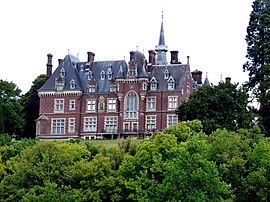Gaillefontaine
Gaillefontaine | |
|---|---|
 The chateau in Gaillefontaine | |
show Location of Gaillefontaine | |
 Gaillefontaine | |
| Coordinates: 49°39′16″N 1°37′01″E / 49.6544°N 1.6169°ECoordinates: 49°39′16″N 1°37′01″E / 49.6544°N 1.6169°E | |
| Country | France |
| Region | Normandy |
| Department | Seine-Maritime |
| Arrondissement | Dieppe |
| Canton | Gournay-en-Bray |
| Intercommunality | CC 4 rivières |
| Government | |
| • Mayor (2020–2026) | Jean-Pierre Henry[1] |
| Area 1 | 26.23 km2 (10.13 sq mi) |
| Population (Jan. 2018)[2] | 1,223 |
| • Density | 47/km2 (120/sq mi) |
| Time zone | UTC+01:00 (CET) |
| • Summer (DST) | UTC+02:00 (CEST) |
| INSEE/Postal code | 76295 /76870 |
| Elevation | 143–246 m (469–807 ft) (avg. 246 m or 807 ft) |
| 1 French Land Register data, which excludes lakes, ponds, glaciers > 1 km2 (0.386 sq mi or 247 acres) and river estuaries. | |
Gaillefontaine is a commune in the Seine-Maritime department in the Normandy region in northern France.
Geography[]
A small town of farming, forestry and light industry situated by the banks of the river Béthune in the Pays de Bray, some 36 miles (58 km) southeast of Dieppe, at the junction of the D919, the D9 and the D135 roads.
Population[]
| Year | 1962 | 1968 | 1975 | 1982 | 1990 | 1999 | 2006 |
|---|---|---|---|---|---|---|---|
| Population | 1232 | 1452 | 1503 | 1373 | 1446 | 1460 | 1417 |
| From the year 1962 on: No double counting—residents of multiple communes (e.g. students and military personnel) are counted only once. | |||||||
Places of interest[]
- The eleventh-century church of St.Jean-Baptiste at the hamlet of Noyers.
- The eleventh-century church of St.Maurice.
- The church of Notre-Dame, dating from the thirteenth century.
- Some 17th-century remains of the abbey.
- The remains of the 11th-century .
- The
- The , dating from the nineteenth century.
- Several old houses, dating from the sixteenth century.
See also[]
- Communes of the Seine-Maritime department
References[]
- ^ "Répertoire national des élus: les maires". data.gouv.fr, Plateforme ouverte des données publiques françaises (in French). 2 December 2020.
- ^ "Populations légales 2018". INSEE. 28 December 2020.
External links[]
| Wikimedia Commons has media related to Gaillefontaine. |
- Official commune website (in French)
Categories:
- Communes of Seine-Maritime
- Dieppe geography stubs


